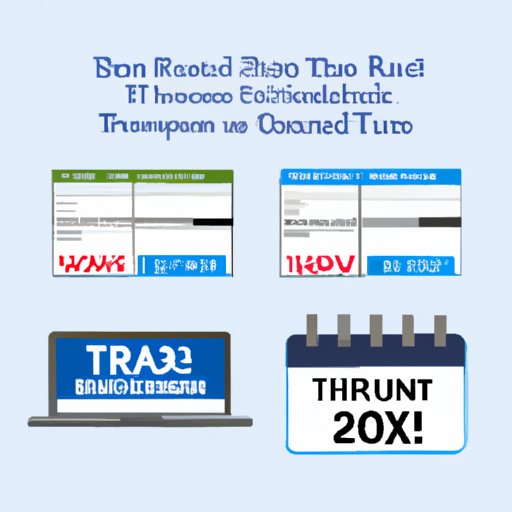Introduction
Tax season is upon us yet again. As you prepare to file your taxes, you may be wondering how long it will take to receive your tax refund. It’s important to understand the timeline of receiving a tax refund so that you can plan accordingly. This article provides an overview of the process and offers helpful tips for minimizing the wait time for your tax refund.

A Guide to Understanding How Long it Takes to Receive Your Tax Refund
Timing is Everything: Exploring the Average Length of Time it Takes to Receive a Tax Refund
The average length of time it takes to receive a tax refund can vary depending on a few factors. According to the Internal Revenue Service (IRS), the majority of refunds are issued within 21 days after filing electronically with direct deposit. However, if you mailed a paper return, the processing time can increase to as much as six weeks. Additionally, if you claim certain credits such as the Earned Income Tax Credit (EITC) or the Additional Child Tax Credit (ACTC), it can take up to five months to receive your refund.
The Wait is Over: Uncovering the Timeline for Receiving Your Tax Refund
It’s important to understand the timeline of receiving your tax refund. The first step is to file your taxes either electronically or by mail. Once the IRS receives your return, it typically takes one to three weeks to process. After processing, the IRS will either send you a check or deposit the funds directly into your bank account. If you choose to have your refund deposited directly into your bank account, the funds should arrive within three to five business days. If you choose to receive a physical check, it could take up to two weeks for the check to arrive in the mail.
Speeding Up the Process: Tips for Minimizing the Wait Time for Your Tax Refund
If you want to get your tax refund faster, there are certain steps you can take to minimize your wait time. Here are some tips for speeding up the process:
File Early
One of the best ways to ensure that you receive your tax refund quickly is to file as early as possible. The earlier you file, the sooner the IRS can begin processing your return. Additionally, filing early allows you to beat the rush of post-April 15th filings, which can help reduce processing time.
Check Your Status Regularly
Once you’ve filed your taxes, you can use the IRS “Where’s My Refund” tool to track the status of your refund. This tool allows you to see when your return has been processed and when you can expect to receive your refund. You can access the “Where’s My Refund” tool using the IRS website or its mobile app.
Use Direct Deposit
Another way to speed up the process is to opt for direct deposit. Choosing direct deposit ensures that your refund will arrive in your bank account within three to five business days. Additionally, opting for direct deposit eliminates the risk of your check being lost in the mail.
Navigating the Maze: A Step-by-Step Guide to Getting Your Tax Refund Quickly and Efficiently
In order to maximize the speed at which you receive your tax refund, it’s important to understand the entire process. Here’s a step-by-step guide to getting your tax refund quickly and efficiently:
Gather Necessary Documents
Before filing your taxes, make sure you have all the necessary documents. This includes W-2s and 1099s from employers, Social Security numbers for each person listed on the return, bank account information for direct deposit, and any other relevant documents. Having all the necessary documents will make the filing process go more smoothly.
Choose the Right Filing Method
Once you’ve gathered all the necessary documents, it’s time to decide which filing method to use. The most popular methods are filing electronically or filing by mail. Filing electronically is usually the fastest option, as it allows the IRS to process your return within one to three weeks. In contrast, filing by mail can take up to six weeks for the IRS to process your return.
Double-Check Your Return
Before submitting your return, make sure to double check it for errors. Even small mistakes can lead to delays in processing your return and receiving your refund. By taking the extra few minutes to double check your return, you can save yourself a lot of time in the long run.
Conclusion
Filing taxes can be a stressful process, especially when it comes to waiting for your refund. Knowing how long it takes to receive your tax refund and what steps you can take to expedite the process can help ease your anxiety. By filing early, checking your status regularly, and using direct deposit, you can ensure that you receive your tax refund as quickly as possible.
(Note: Is this article not meeting your expectations? Do you have knowledge or insights to share? Unlock new opportunities and expand your reach by joining our authors team. Click Registration to join us and share your expertise with our readers.)
